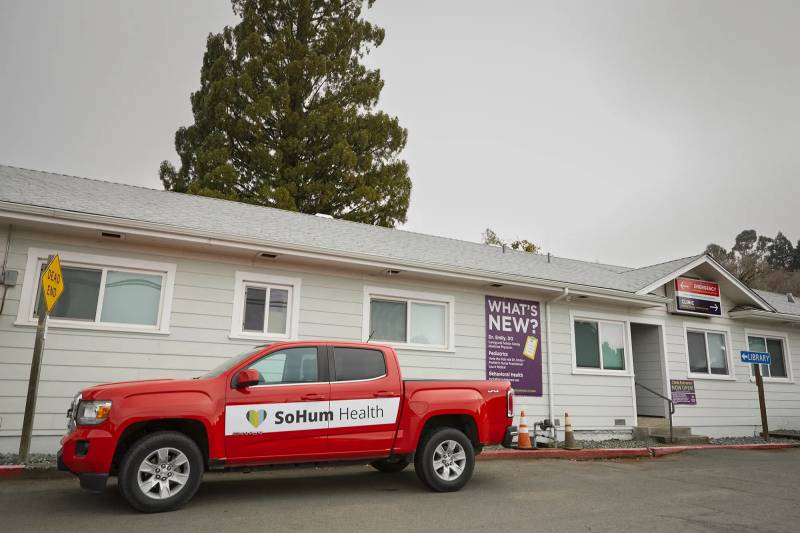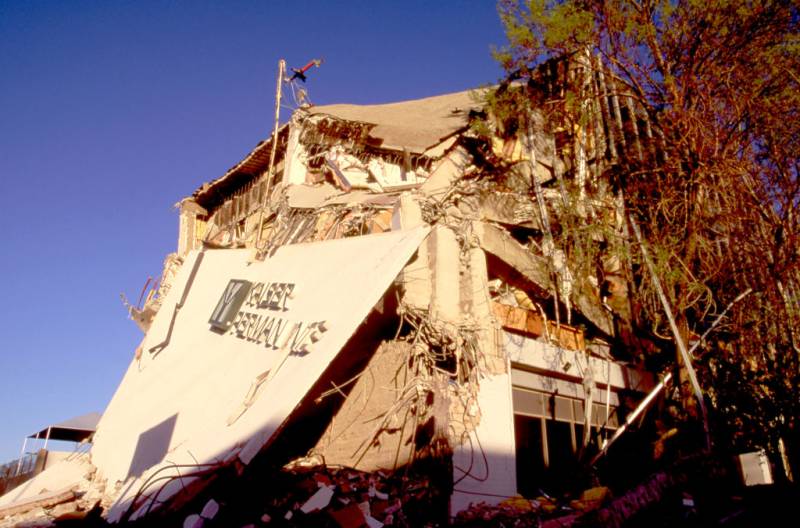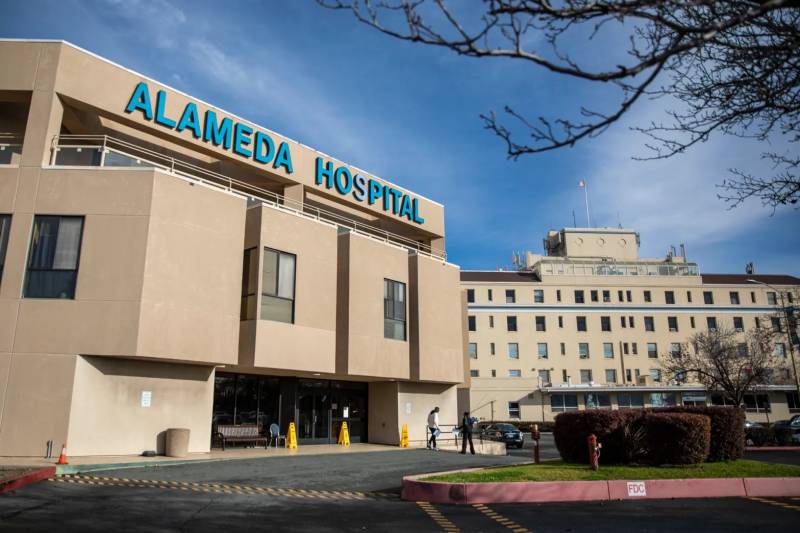

Jerold Phelps Community Hospital in Garberville is one of the smallest in the country. Its mere nine acute-care beds serve a community of about 10,000 people in southern Humboldt County. The next closest emergency room is about an hour’s drive north.
Despite its small size, the hospital is facing a hefty price tag to meet the 2030 retrofit deadline required under the state’s seismic safety standards — about $50 million for a new single story hospital that would replace its 1960s building.
Although it’s been decades since California implemented its strict seismic safety requirements, paying for those upgrades continues to be a tough task, especially for smaller facilities with limited resources and funding, according to hospital officials across the state. Like Jerold Phelps Community Hospital, two-thirds of California hospitals have yet to meet the looming state seismic deadline that requires hospital buildings to be updated to ensure they can keep operating after an earthquake.
The 6.4 magnitude quake that struck the Humboldt area on Dec. 20 was a stark reminder of California’s vulnerability to seismic activity. Hospitals in the county reported minimal damage and no threat to patients. Two hospitals, in Eureka and Fortuna, lost power and needed generators, according to the California Office of Emergency Services.
'They have had many, many, many years to do this, and to now say they need an extension is just not appropriate. I think they can do it.' Cathy Kennedy, president, California Nurses Association
Hospital administrators acknowledge their buildings need to remain safe and available for emergency services following a quake, but they say they need more time to complete their upgrades and construction projects, especially as many are still reeling from the financial strains of responding to the COVID-19 pandemic. Officials at smaller hospitals say that in addition to time, they need funding. They also want more flexibility. The Legislature, they say, should revisit the rules and grant them more leeway for buildings that provide non-emergency services.
“Everyone wants to make our hospitals safe — that’s not the issue. It’s just a tremendous amount of capital that is being poured into this,” said Debi Stebbins, executive director at the City of Alameda Health Care District, which oversees Alameda Hospital.
The seismic safety standards debate is a familiar one in Sacramento, and one that hospital administrators expect will come up again during this new legislative term. Officials at the California Hospital Association said their immediate goal is to educate the large new class of lawmakers about the state’s seismic safety laws and the challenges hospitals face.
Labor groups, however, have strongly opposed hospitals’ ongoing requests for deadline extensions and amendments. They argue that hospitals have had plenty of time — about 30 years — to bring their buildings up to the required standards.
“They have had many, many, many years to do this, and to now say they need an extension is just not appropriate,” said Cathy Kennedy, president of the California Nurses Association. “I think they can do it.”
In the early hours of Jan. 17, 1994, a 6.7 magnitude earthquake centered in Northridge shook Southern California. The earthquake killed at least 57 people and injured thousands. It resulted in about $20 billion in damages and about $40 billion in economic loss, making it the most costly earthquake in U.S. history, according to the California Department of Conservation.
Twelve hospital buildings sustained severe structural damage and had to be evacuated. In response to the Northridge earthquake, California lawmakers passed a law that fortified the state’s existing seismic safety standards for hospitals.
The law requires hospitals to either upgrade their existing buildings or replace them to ensure safety. Buildings that don’t meet the earthquake standards have to cease operating.

The first set of requirements (with an original deadline of 2008 but eventually pushed back 12 years, to 2020) mandated that hospital buildings be structurally fit enough to remain standing after an earthquake. Most hospitals have met this deadline, but 23 facilities out of 414 have at least one building that has yet to comply, according to data tracked by the California Department of Health Care Access and Information. The state gave those hospitals a couple of more years, until 2025 in some cases, to come into compliance.
The second deadline, set for 2030 and the one being debated, requires hospital buildings to also remain fully functional and be able to provide services following a quake. Currently, about 62% of hospitals have at least one building that has yet to meet the 2030 structural standards.
Hospitals are also required to make “non-structural” improvements by 2030 so that their systems, including water supply (PDF) and equipment, can support at least 72 hours of operation after an earthquake. And while 2030 may seem a long way out, several hospital executives said that if hospitals have not yet started their upgrade plans, they may struggle to meet that deadline.
“We want to make sure they (lawmakers) understand that hospitals’ buildings are safe given the first seismic deadline, but that this next deadline could have very dire consequences for their communities,” like the closure of hospitals, said Kiyomi Burchill, group vice president of policy at the California Hospital Association.
Engineers say that meeting the 2020 safety requirement so that hospitals won’t collapse was a big achievement, but not sufficient. Buildings also need to function.
“If you have a hospital that serves a population that may not have a lot of mobility, say a disadvantaged population, and that hospital can’t work after an earthquake when you might have a lot of injuries, that is a big problem,” said Jonathan Stewart, professor of civil and environmental engineering at UCLA.
Because needs and resources can differ by hospital, Stewart said it makes sense to review extension requests on a case-by-case basis. “I think we have to respect the appeal made by [hospital] administrators and where reasonable grant an extension, but maybe not in all cases because there could be cases where hospitals reasonably could do it and they’re just not prioritizing it.”
Devon Lumbard, an engineer with the Structural Engineers Association of California, said that any potential extensions for hospitals should come with a clear way to measure incremental progress.
“The key issue is if it’s an ask that doesn’t have a clear process for how it will demonstrate continued compliance and ultimately achieve the goal, that’s concerning,” he said. “If we just move the goal post, that’s not good, or take the goal post away and reduce requirements, that’s a concern.”
Seismic upgrades and construction are estimated to cost hospitals across the state from $34 billion to $143 billion, according to a 2019 study the think tank RAND Corporation did for the California Hospital Association. The lower price is the cost to retrofit buildings, the high one is for building new. Although some experts say the state is due for a more updated cost assessment.
The RAND study found that the cost of upgrades would put 40% of California’s hospitals in “severe financial distress,” with community and public hospitals taking the biggest hit.
“And so that’s why it hasn’t been done. That’s why everybody’s asking for extensions, because it’s just an insurmountable amount of money,” said Matt Rees, CEO of Southern Humboldt Health, which oversees Jerold Phelps Community Hospital.
'Everyone wants to make our hospitals safe — that's not the issue. It's just a tremendous amount of capital that is being poured into this.' Debi Stebbins, executive director, City of Alameda Health Care District
Labor unions and others opposing extensions will often point to systems like Kaiser Permanente, which raked in $8.1 billion in profits in 2021, a record for the health care giant. But not all hospitals have that kind of money, Stebbins said.
For example, public hospitals typically rely on bonds or loans to fund construction projects. Campaigning for a bond measure is expensive and a tough sell to voters. “In this economic time I would hate to be floating a bond measure to the electorate,” Stebbins said.
California soon will provide at least some aid to small and rural hospitals for these projects through grants funded by the state’s e-cigarette tax. The first round of funding is expected to be made available by April of this year. Although it is unclear how much each hospital would get.
Hospital executives also say there is irony in having to spend billions on these projects while at the same time being asked by the state to control costs.
“Our focus should be on improving health outcomes, keeping health services affordable, and investing in developing the delivery system of the future, not on expensive operational mandates that will further drive up the cost of care for patients,” Shelly Schlenker, executive vice president for Dignity Health, said in an email statement.
Dignity Health, which operates 31 hospitals in the state, so far has spent about $2 billion in upgrades, Schlenker said. As of now, Dignity Health expects its hospitals will be compliant with the state requirements by 2030, she said.
In the past, hospital groups have in large part been successful in securing extensions. But hospital lobbyists say time alone doesn’t solve the problem. Ideally, an extension would come with some creative financing solutions, said Sarah Bridge, a lobbyist for the Association of California Healthcare Districts.
In the midst of last year’s budget surplus projections, Assemblymember Eduardo Garcia, a Coachella Democrat, sought to secure $1 billion in the state budget to help California’s 32 district hospitals with their seismic projects, but those efforts ultimately went nowhere. District hospitals are public hospitals governed by an elected board and largely located in underserved areas.
“I think the problem with just giving an extension, which would be welcomed, is we run up against the same problem at the end of it. We still can’t fund the project,” Bridge said. Still, “at the very least an extension would buy us more time, and allow us to get contractors to our areas to build these projects.” Hospitals in the state all have the same deadline and are all vying for the same contractor workforce, she said.
In search of its own solution, Alameda Hospital, which serves the city of Alameda, a Bay Area island community of about 80,000 people, sought its own two-year extension during the last legislative session. The bill made it out of the Legislature but was vetoed by Gov. Gavin Newsom.

In his veto message (PDF), Newsom said any consideration of a deadline extension must occur in a comprehensive manner and include all types of facilities — which some hospital officials took as an indicator that his administration is open to a statewide extension.
When asked if the governor was open to pushing back the 2030 deadline, his office only said that it would carefully review any new legislation.
Last summer, the California Hospital Association also sought the support of a powerful health worker labor group, SEIU-UHW, in a last-minute deal that would have delayed the seismic deadline seven years in exchange for boosting the minimum wage for hospital workers. But those negotiations quickly fizzled.
One reason Jerold Phelps Community Hospital in Humboldt County couldn’t start planning its seismic safety projects sooner is because it has spent the last couple of decades working its way out of a financial crisis, Rees said.
In 2000, the hospital filed for bankruptcy (PDF). And in order to qualify for a loan to fund its construction project, the hospital first needed to be in good financial standing. For the past three years, the hospital has been busy raising $4 million for the downpayment for a federal loan.
The financial plight of small hospitals is well documented. Just last week Madera Community Hospital closed its doors due to financial constraints.
The hospital, in the Central Valley city of Madera, was set to be sold to Trinity Health Corporation, but that deal fell through. That means residents of that community will have to travel about 40 minutes to the next closest emergency room. Trinity Health did not respond to requests for comment on why it backed out of the purchase.
The Office of the Attorney General, which has to approve certain healthcare acquisitions, said in a written statement that Trinity Health refused to meet basic conditions, such as agreeing to keep services affordable. Among the requirements set by the Attorney General: that the corporation invest $45 million in medical records upgrades and seismic retrofitting.
Kennedy, with the nurses union, said she agrees that smaller and rural hospitals absolutely need assistance, but that the solution is not to continue delaying deadlines.
“As a nurse I know that it’s those small rural hospitals that need to stay up and running more than ever (after an earthquake),” she said. “That’s what the Legislature and Gov. Newsom need to look at. Not just kick the can down the road, but do something about it, and they’ve had a lot of time to really think about this.”
How soon hospitals get to these projects is also about right timing, said Julia Drefke, government relations director with Adventist Health, which operates 20 hospitals in California, about 80% of them in rural parts of the state. It is typical for Adventist hospitals to plan projects seven to 10 years out, she said.
“You want to plan in advance for your building, but can’t plan too far in advance,” because healthcare trends and needs of communities can change over time as they saw with COVID-19, she explained.
“Now we’re seven years out (from the deadline) so now we can ask ‘What does that look like?’” she said.
Glenn Melnick, a health economist at the University of Southern California, said progress could be slow because there isn’t much financial incentive for them to move quickly on these projects. And “If nobody is moving quickly, it kind of builds the case for another extension,” he said.
Add to that the current high interest rates on loans and the financial shock of COVID, he said. “The stars are aligning in a negative way for hospitals that haven’t already done this.”